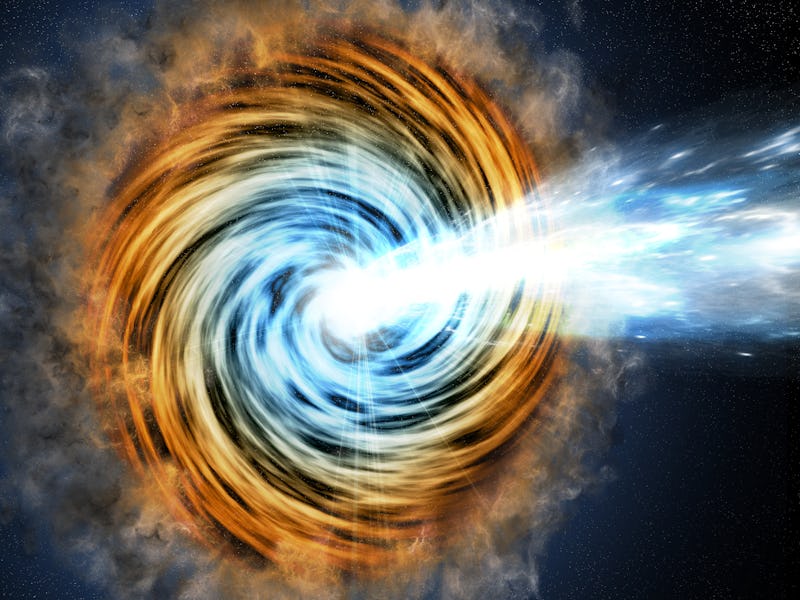Scientists Just Found Gamma Rays That are Older Than Earth
They're calling it a 'blazar bonanza.'

In April, a flood of powerful gamma rays that had been traveling from halfway across the universe found their way into Earth’s neighborhood.
By some miraculous chance, NASA’s Fermi Gamma-ray Space Telescope was floating up in Earth’s orbit and managed to capture the outburst, collecting a ton of valuable data from a rare cosmic event.
A new study illustrates new analysis of the event, which could shed light on what the middle ages of the universe might have looked like, as well provide some more insight into how cosmic gamma rays are produced and how they behave.
First, some perspective:
These particular gamma rays — some of the highest-energy light to ever be observed and from the farthest distance away — actually originate from a supermassive black at the center of distant “blazar” galaxy called PKS 1441+25. This particular supermassive black hole, common to all blazars, is 70 million times more massive than the sun. Blazars are some of the most energetic celestial phenomena to exist in the known universe.
NASA’s Fermi Gamma-ray Space Telescope.
When PKS 1441+25 ripped out a major flare in April, astronomers from the Major Atmospheric Gamma Imaging Cherenkov Telescope, or MAGIC, based on La Palma in the Canary Islands, discovered the gamma ray outburst from the Fermi data.
The, uhh, MAGIC act did some follow analysis, and determined that the gamma rays being spewed off by PKS 1441+25 were over nine to 10 billion times the energy of visible light — which was a surprise since the galaxy is so far away. Gamma rays convert into particles when they collide with low-energy light, so they basically lose power the farther they go. Starlight is kind of light the kryptonite of gamma rays.
A graphic of how gamma rays travel through the universe.
So in order for the gamma rays to make it to us as bright as they did, they needed to avoid the tight net of photons that immediately surround black holes, as well as bypass the extragalactic background light, or EBL, that permeates through the rest of the universe. (The “EBL” is essentially the collection of faint light between all stars and galaxies to have ever existed.)
Now, there’s no real way for the gamma rays in this instance to avoid the EBL. And that’s a good thing — the study authors used measurements to help calculate a new, more accurate understanding of how powerful the EBL is. So, in effect, the gamma rays being slowly chipped away by the EBL was a blessing.
The VERITAS (Very Energetic Radiation Imaging Telescope Array System) in southern Arizona.
But how did the rays avoid the net of photons surrounding a supermassive black hole? That’s where we’re introduced to another team of astronomers, from the Very Energetic Radiation Imaging Telescope Array System in Arizona. They observed some strange measurements that didn’t correlate with their initial assumption that gamma rays were produced in areas closest to the black hole.
Instead, the VERITAS team found that the emission region for these gamma rays, plus other light at different energies, were all coming out of a single region that’s actually five light-years away from the black hole itself — bigger than the distance between the sun and the nearest star. When matter falls into a black hole, it’s sometimes ejected like a powerful jet from the poles of the spinning disk of nothingness. For PKS 1441+25, one of these jets is pointing straight at Earth. (Kinda scary, right?)
It’s suspected that this jet plays a role in shifting the gamma ray emission-point away from the black hole, allowing them to escape the all-powerful gravitation pull as well as, in effect, helping them avoid annihilation via the photon net.
It’s wicked stuff, but more importantly, the new data helps explain how much older parts of the universe have behaved. Something like PKS 1441+25 has never really been found closer to Earth, and studying light that has traveled from such far distances helps to paint a picture of what the early universe was.
It’ll be fascinating to see what else astronomers are able to glean from this data. For now, let’s just bask in the knowledge that there’s a blazar in the distance shooting high-energy rays at our planet.
Just some 7.6 billion-year-old Gamma rays.